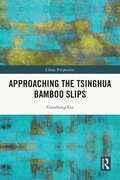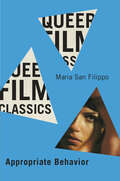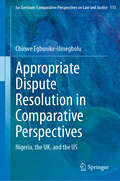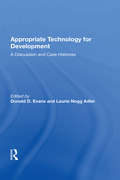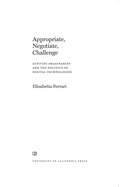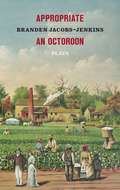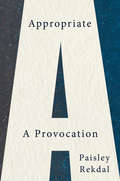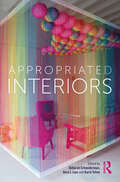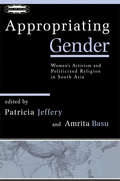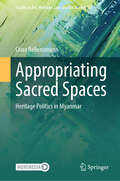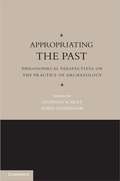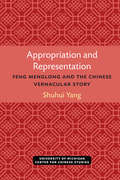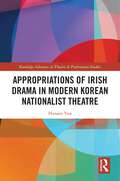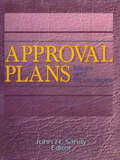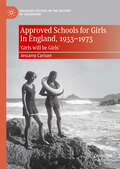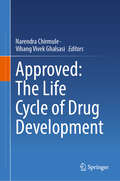- Table View
- List View
Approaching the Tsinghua Bamboo Slips (ISSN)
by Guozhong LiuThis book provides a detailed introduction to the study of the Tsinghua Bamboo Slips, explaining the preservation and analysis of the artifacts and their significance in historical research of the pre-Qin period.The Tsinghua Bamboo Slips are a collection of Chinese texts inscribed on approximately 2,500 bamboo slips. They were excavated from a Warring States Period tomb and are now preserved at Tsinghua University. The book delves into the traditions and discoveries of bamboo manuscripts in China and discusses the preservation and research of the slips, covering the procedures of artifact processing, authentication, digitization, editing, and interpretation. The manuscripts are remarkable for their quantity, period of creation, and distinctive content coverage. They contain important historical documents that differ from or are missing from the extant literature. The analysis of these texts helps to unravel some of the unresolved mysteries in pre-Qin historical studies and illuminates scientific achievements of ancient China previously unknown to the world.This book is essential reading for scholars and students of Chinese studies, pre-Qin history, and early literacy. It will also appeal to general readers interested in ancient Chinese history and culture.
Appropriate Behavior (Queer Film Classics)
by Maria San FilippoPremiering at Sundance in 2014, Desiree Akhavan’s acclaimed debut feature, Appropriate Behavior, introduced the indie film world to the deadpan, irreverent wit that had already won over fans of her trailblazing LGBTQ web series The Slope. The first volume in the Queer Film Classics series to spotlight a work by and about a bisexual woman of colour, this book explores Appropriate Behavior as an instant classic of US indie filmmaking in the 2010s, as a radical reappropriation of straight and gay film genres, as an artist’s coming-of-age story, and as a model for feminist-queer creative collaboration. Less than a decade old, Appropriate Behavior captures an urban queer community imperilled by gentrification and homonormativity and serves as exemplar of an innovative wave of independent cinema not yet subsumed by the streaming economy. Maria San Filippo explores how filmmaker and film render a singular voice and story that queers not only its celebrated romcom predecessors but also the gay coming-out film and the lesbian romance alike. The book concludes with an interview with Akhavan.San Filippo pays special tribute to Akhavan’s audacious sensibility and the “inbetweener” moxie that makes Appropriate Behavior an unparalleled portrayal of bisexuality.
Appropriate Dispute Resolution in Comparative Perspectives: Nigeria, the UK, and the US (Ius Gentium: Comparative Perspectives on Law and Justice #113)
by Chinwe Egbunike-UmegboluThis book explores the various types of Appropriate Dispute Resolution (ADR) applied in Nigeria, the UK, and the US. It critically examines the effectiveness of mediation, arbitration, restorative justice, collaborative law, and online dispute resolution (ODR) in settling disputes or conflicts, while also demonstrating the benefits of ADR and multi-door courthouses (MDCs). The book provides a concise introduction to the resolution of disputes or conflicts in Africa prior to the advent of colonial rule. It suggests that a ‘legal transplant’ can also take place from a less complex society to a more complex one, contrary to the general belief that legal transplants usually proceed from a more complex society to a less complex one.The book aims to help people understand ADR mechanisms and the advantages of settling disputes using means other than litigation. It presents Traditional African Methods of Settling Disputes (TAMSD), Early Dispute Resolution (EDR), arbitration, negotiation, ODR, collaborative law, restorative justice, conciliation, ombuds, and early neutral evaluation as viable alternatives. It also highlights the need for clinical legal education and effective messaging that highlights the benefits of ADR compared to traditional litigation. In turn, it analyses the use of ADR, especially mediation and collaborative law, to settle disputes in criminal law, restorative justice, employment law, and business and human rights due diligence/violation cases. Further, the book demonstrates that criminal matters are now under the scope of ADR via Restorative Justice Door.The book discusses the skills, techniques, and relevant statutory frameworks for each field of Appropriate Dispute Resolution and provides national and international examples of the application of the relevant principles. Addressing the fields of Appropriate Dispute Resolution (ADR), criminal law, civil law, business management, psychology, employment law, humanresource management, and African studies, it will appeal to a wide readership.
Appropriate Environments for Children under Three (Supporting Children from Birth to Three)
by Helen BradfordIt is widely known that babies and infants will flourish in an environment that supports and promotes their learning and development. But what constitutes an appropriate environment for children under three? Drawing on recent research, this book explores the concept of an appropriate environment, both within and beyond the early years setting. It sets this within the context of child development and practically demonstrates how a high quality environment can be created for babies and toddlers that supports the areas of learning and development. Features include: case studies and examples focus points for readers and questions for reflective practice suggestions for staff development photos to illustrate good practice. Providing a wealth of practical ideas and activities, this handy text provides detailed guidance on how to develop an appropriate indoor and outdoor environment for babies and toddlers’ to help practitioners ensure effective outcomes for the youngest children in their care.
Appropriate Technology For Development: A Discussion And Case Histories (Westview Special Studies In Social, Political, And Economic Development)
by Donald D. EvansThis analysis of appropriate technology first explores the concept of development in terms of needs, characteristics, and theories and then examines the pivotal role of technology in the developmental process. The twenty contemporary case histories illustrate specific instances of applied technology, not necessarily as examples of successful applic
Appropriate Technology in Vector Control
by Christopher F. CurtisThis book was first published in 1990. It discusses a plethora of both high and low tech options for the control of vectors such as mosquitos in the spread of disease.
Appropriate Use of Advanced Technologies for Radiation Therapy and Surgery in Oncology: Workshop Summary
by Engineering Medicine National Academies of SciencesIn recent years, the field of oncology has witnessed a number of technological advances, including more precise radiation therapy and minimally invasive surgical techniques. Three-dimensional (3D), stereotactic, and proton-beam radiation therapy, as well as laparoscopy and robotic surgery, can enhance clinician's ability to treat conditions that were clinically challenging with conventional technologies, and may improve clinical outcomes or reduce treatment-related problems for some patients. Both patients and physicians seek access to these new technologies, which are rapidly being adopted into standard clinical practice. Such demand is often propelled by marketing that portrays the new technologies as the “latest and greatest” treatments available. However, evidence is often lacking to support these claims, and these novel technologies usually come with higher price tags and are often used to treat patients who might have achieved similar benefits from less expensive, conventional treatment. The increased cost of novel treatments without adequate assessment of how they affect patient outcomes is a pressing concern given that inappropriate use of expensive technologies is one of the key factors that threaten the affordability of cancer care in the United States. To explore these issues further, the National Cancer Policy Forum (NCPF) of the Institute of Medicine organized a workshop in July 2015. This is the third NCPF workshop in a series examining the affordability of cancer care. Participants explored clinical benefits and comparative effectiveness of emerging advanced technologies for cancer treatment in radiation therapy and surgery and potential strategies to assess the value and promote optimal use of new technologies in cancer treatment. This report summarizes the presentations and discussions from the workshop.
Appropriate, Negotiate, Challenge: Activist Imaginaries and the Politics of Digital Technologies
by Dr. Elisabetta FerrariActivists use digital technologies to communicate, coordinate, and organize for social change. But these big corporate digital platforms are also used to spread disinformation, racism, and abuse. Appropriate, Negotiate, Challenge investigates the relationship between activism and technology, focusing on how activists think and talk about technology’s role in social change and what this tells us about the politics of digital technologies. Researching movements in Italy, Hungary, and the United States, Elisabetta Ferrari examines how leftist activists construct technological imaginaries that appropriate, negotiate, and challenge Silicon Valley’s vision of technology. She argues that these imaginaries reflect and shape the politics of social movements: they matter for how activists think about their political possibilities. Ultimately, Ferrari centers the political and imaginative work that activists need to perform in order to navigate the politics of mainstream digital technologies.
Appropriate/An Octoroon: Plays
by Branden Jacobs-Jenkins<p>A double-volume containing two astonishing breakout plays from one of the theatre's most exciting and provocative young writers. <p>In Appropriate, strained familial dynamics collide with a tense undercurrent of socio-political realities when the Lafayettes gather at a former plantation home to sift through the belongings of their deceased patriarch. An Octoroon is an audacious investigation of theatre and identity, wherein an old play gives way to a startlingly original piece. <p>Also includes the short play I Promise Never Again to Write Plays About Asians...</p>
Appropriate: A Provocation
by Paisley RekdalA timely, nuanced work that dissects the thorny debate around cultural appropriation and the literary imagination. How do we properly define cultural appropriation, and is it always wrong? If we can write in the voice of another, should we? And if so, what questions do we need to consider first? In Appropriate, creative writing professor Paisley Rekdal addresses a young writer to delineate how the idea of cultural appropriation has evolved—and perhaps calcified—in our political climate. What follows is a penetrating exploration of fluctuating literary power and authorial privilege, about whiteness and what we really mean by the term empathy, that examines writers from William Styron to Peter Ho Davies to Jeanine Cummins. Lucid, reflective, and astute, Appropriate presents a generous new framework for one of the most controversial subjects in contemporary literature.
Appropriated Interiors
by Anca I. Lasc Deborah Schneiderman Karin TehveAppropriated Interiors uncovers the ways interiors participate explicitly and implicitly in embedded cultural and societal values and explores timely emergent scholarship in the fields of interior design history, theory, and practice. What is "appropriate" and "inappropriate" now? These are terms with particular interest to the study of the interior. Featuring thirteen original curated essays, Appropriated Interiors explores the tensions between normative interiors that express the dominant cultural values of a society and interiors that express new, changing, and even transgressive values. With case studies from the late eighteenth century to the twenty-first century, these historians, theorists, and design practitioners investigate the implications of interior design as it relates to politics, gender, identity, spatial abstraction, cultural expression, racial expression, technology, and much more. An informative read for students and scholars of design history and theory, this collection considers the standards, assumptions, codes, and/or conventions that need to be dismantled and how we can expand our understanding of the history, theory, and practice of interior design to challenge the status quo.
Appropriately Indian: Gender and Culture in a New Transnational Class
by Smitha RadhakrishnanAppropriately Indian is an ethnographic analysis of the class of information technology professionals at the symbolic helm of globalizing India. Comprising a small but prestigious segment of India's labor force, these transnational knowledge workers dominate the country's economic and cultural scene, as do their notions of what it means to be Indian. Drawing on the stories of Indian professionals in Mumbai, Bangalore, Silicon Valley, and South Africa, Smitha Radhakrishnan explains how these high-tech workers create a "global Indianness" by transforming the diversity of Indian cultural practices into a generic, mobile set of "Indian" norms. Female information technology professionals are particularly influential. By reconfiguring notions of respectable femininity and the "good" Indian family, they are reshaping ideas about what it means to be Indian. Radhakrishnan explains how this transnational class creates an Indian culture that is self-consciously distinct from Western culture, yet compatible with Western cosmopolitan lifestyles. She describes the material and symbolic privileges that accrue to India's high-tech workers, who often claim ordinary middle-class backgrounds, but are overwhelmingly urban and upper caste. They are also distinctly apolitical and individualistic. Members of this elite class practice a decontextualized version of Hinduism, and they absorb the ideas and values that circulate through both Indian and non-Indian multinational corporations. Ultimately, though, global Indianness is rooted and configured in the gendered sphere of home and family.
Appropriating Blackness: Performance and the Politics of Authenticity
by E. Patrick JohnsonPerformance artist and scholar E. Patrick Johnson's provocative study examines how blackness is appropriated and performed--toward widely divergent ends--both within and outside African American culture. Appropriating Blackness develops from the contention that blackness in the United States is necessarily a politicized identity--avowed and disavowed, attractive and repellent, fixed and malleable. Drawing on performance theory, queer studies, literary analysis, film criticism, and ethnographic fieldwork, Johnson describes how diverse constituencies persistently try to prescribe the boundaries of "authentic" blackness and how performance highlights the futility of such enterprises. Johnson looks at various sites of performed blackness, including Marlon Riggs's influential documentary Black Is . . . Black Ain't and comedic routines by Eddie Murphy, David Alan Grier, and Damon Wayans. He analyzes nationalist writings by Amiri Baraka and Eldridge Cleaver, the vernacular of black gay culture, an oral history of his grandmother's experience as a domestic worker in the South, gospel music as performed by a white Australian choir, and pedagogy in a performance studies classroom. By exploring the divergent aims and effects of these performances--ranging from resisting racism, sexism, and homophobia to excluding sexual dissidents from the black community--Johnson deftly analyzes the multiple significations of blackness and their myriad political implications. His reflexive account considers his own complicity, as ethnographer and teacher, in authenticating narratives of blackness.
Appropriating Gender: Women's Activism and Politicized Religion in South Asia (Zones of Religion)
by Amrita Basu Patricia JefferyAppropriating Gender explores the paradoxical relationship of women to religious politics in India, Pakistan, Sri Lanka, and Bangladesh. Contrary to the hopes of feminists, many women have responded to religious nationalist appeals; contrary to the hopes of religious nationalists, they have also asserted their gender, class, caste, and religious identities; contrary to the hopes of nation states, they have often challenged state policies and practices. Through a comparative South Asia perspective, Appropriating Gender explores the varied meanings and expressions of gender identity through time, by location, and according to political context. The first work to focus on women's agency and activism within the South Asian context, Appropriating Gender is an outstanding contribution to the field of gender studies.
Appropriating Sacred Spaces: Heritage Politics in Myanmar (Studies in Art, Heritage, Law and the Market #10)
by Clara RellensmannThe book provides deep insights into heritage politics in Myanmar on the basis of the conservation history of Bagan and its entanglement in national politics. It particularly investigates the heritage practice of the dictatorial regime that ruled Myanmar from 1988 to 2011 and highlights the implications of both the reconciliation politics of Aung San Suu Kyi’s NLD government (2016-2020) and the UNESCO World Heritage System. The book examines the function of Bamar-Buddhist architecture in the spatial strategy of the 1988-2011 regime and its nation-building efforts. With a focus on the historic site of Bagan, included on the World Heritage List in 2019, and the “Adopt-a-Pagoda Program” that was implemented at the site from 1995 to 2011 under authoritarian rule, the book provides a detailed account of Bagan’s physical transformation and its political significance for national politics at the time. It offers a historical comparison of the heritage politics of Myanmar’s most recent transitional governments (2011-2020) pointing out the particularities of the country’s institutionalized heritage practice and one-sided nation-building strategy. Both have contributed to continued ethnic conflicts that are generally considered to be the world’s longest civil war. In the renewed dictatorial context of Myanmar since February 1, 2021, the research presented in the book helps to understand the roots of the new regime's heritage practice and national imagination. In addition to these insights into Myanmar’s heritage politics, the book addresses shortcomings of the World Heritage system with regard to the treatment of sacred sites in authoritarian and post-authoritarian contexts, an aspect that to date has been largely neglected in cultural heritage policy debates across the globe.
Appropriating the Past
by Robin Coningham Geoffrey ScarreIn this book an international team of archaeologists, philosophers, lawyers and heritage professionals addresses significant ethical questions about the rights to access, manage and interpret the material remains of the past. The chapters explore competing claims to interpret and appropriate the past and the major ethical issues associated with them, including handling the sacred; contested rights over sites, antiquities and artifacts; the involvement of local communities in archaeological research; and the legal status of heritage sites. The book covers a range of hotly debated topics in contemporary archaeological practice, focusing particularly on the relationship between academic archaeologists and indigenous communities for whom the material remnants of the past that form the archaeological record may be part of a living tradition and anchors of social identity.
Appropriation and Representation: Feng Menglong and the Chinese Vernacular Story (Michigan Monographs In Chinese Studies #79)
by Yang ShuhuiFeng Menglong (1574–1646) was recognized as the most knowledgeable connoisseur of popular literature of his time. He is known today for compiling three famous collections of vernacular short stories, each containing forty stories, collectively known as Sanyan. Appropriation and Representation adapts concepts of ventriloquism and dialogism from Bakhtin and Holquist to explore Feng’s methods of selecting source materials. Shuhui Yang develops a model of development in which Feng’s approach to selecting and working with his source materials becomes clear. More broadly, Appropriation and Representation locates Feng Menglong’s Sanyan in the cultural milieu of the late Ming, including the archaist movement in literature, literati marginality and anxieties, the subversive use of folk works, and the meiren xiangcao tradition—appropriating a female identity to express male frustration. Against this background, a rationale emerges for Feng’s choice to elevate and promote the vernacular story while stepping back form an overt authorial role.
Appropriations of Irish Drama in Modern Korean Nationalist Theatre (Routledge Advances in Theatre & Performance Studies)
by Hunam YunThis book investigates the translation field as a hybrid space for the competing claims between the colonisers and the colonised. By tracing the process of the importation and appropriation of Irish drama in colonial Korea, this study shows how the intervention of the competing agents – both the colonisers and the colonised – formulates the strategies of representation or empowerment in the rival claims of the translation field. This exploration will be of great interest to students and scholars of theatre and performance studies, translation studies, and Asian studies.
Approval Addiction: Overcoming Your Need To Please Everyone
by Joyce Meyer'There is an epidemic of insecurity in our society today. Many people are insecure and feel bad about themselves, which steals their joy and causes major problems in all their relationships.''The good news is that there is a cure for the approval addiction!'APPROVAL ADDICTION asks why so many of us have an overwhelming need for acceptance from the wider world - and provides the key to breaking free from this addiction.Joyce Meyer's groundbreaking book, now available with a new look for the B-format edition:· Demonstrates that you can accept who you are· Identifies the cause of our addictive need for approval· Helps you to be released from the chains of past· Guides you through steps to break the pattern for the futureJoyce writes from raw, personal knowledge of how insecurity and low self-esteem - stemming in her case from damaging childhood experiences - can leave us feeling constantly frustrated and lacking real peace or joy. It was through embracing the knowledge that she is unconditionally loved by God that she found inner security and the power to live her life to her full potential.
Approval Addiction: Overcoming the Need to Please Everyone
by Joyce MeyerThis book addresses the constant need some people have for approval from a religious perspective.
Approval Junkie: Adventures in Caring Too Much
by Faith SalieFrom comedian and journalist Faith Salie, of NPR's Wait Wait...Don't Tell Me! and CBS News Sunday Morning, a collection of daring, funny essays chronicling the author's adventures during her lifelong quest for approval Faith Salie has done it all in the name of validation. Whether it's trying to impress her parents with a perfect GPA, undergoing an exorsism in the hopes of saving her toxic marriage, or maintaining the BMI of "a flapper with a touch of dysentery," Salie is the ultimate approval seeker--an "approval junkie," if you will. In "Miss Aphrodite," she recounts her strategy for winning the high school beauty pageant. ("Not to brag or anything, but no one stood a chance against my emaciated, spastic resolve.") "What I Wore to My Divorce" describes Salie's struggle to pick the perfect outfit to wear to the courthouse to divorce her "wasband." ("I envisioned a look that said, 'Yo, THIS is what you'll be missing...even though you've introduced your new girlfriend to our mutual friends, and she's a decade younger than I am and is also a fit model.") In "Ovary Achiever," she shares tips on how to ace your egg retrieval. ("Thank your fertility doctor when she announces you have 'amazing ovaries.' Try to be humble about it ['Oh,these old things?'].") And in "Wait, Wait, Don't Tell Me About Batman's Nipples" she reveals the secrets behind Wait Wait...Don't Tell Me! ("I study for this show like Tracy Flick on Adderall"). With thoughtful irreverence, Salie reflects on why she tries so hard to please others, and herself, highlighting a phenomenon that many people--especially women--experience at home and in the workplace. Equal parts laugh-out loud funny and poignant, Approval Junkie is one woman's journey to realizing that seeking approval from others is more than just getting them to like you--it's challenging yourself to achieve, and survive, more than you ever thought you could.From the Hardcover edition.
Approval Plans: Issues and Innovations
by Linda S Katz John H SandyHow can you, as an acquisition librarians, keep current on the output of hundreds of publishers? The answer, of course, is that you cannot. For over 30 years, approval plans have been used by librarians to acquire current titles, save staff time, and build core collections. Even today, these reasons seem appropriate, as libraries try to maintain up-to-date collections and control personnel and operating budgets. However, as shown in Approval Plans: Issues and Innovations, the use of approval plans is not so simple and straightforward; their use is subject to complex procedures and policies--and even politics. This book presents research by librarians from academic libraries and professionals from approval vendors to give you necessary insight on the major approval plan issues and to show you some of the innovative approaches to solving the problems associated with approval plans. Unfortunately, approval plans are not as simple as creating a “needs” profile and receiving the books that match that profile from an approval vendor. Problems and questions invariably arise. If you are in acquisitions and collection development or administration, it is particularly important that you explore the following questions posed in Approval Plans: What mechanisms can reduce receipt of duplicate titles? Do vendors see small college libraries as a viable market? What role does technology play in improving approval plans? What level of returns is acceptable? Do the hidden operational costs of approval plans offset their benefits? Approval Plans is full of useful information that will show you how to save time and money, improve collections, and utilize new technology. The book discusses such key issues as: the benefits of approval plans to public service vs. the costs to technical service; the call for refined profiles to help keep return rates low; proper management in key areas such as profile development, quality control, and plan maintenance; approval plan overlap; and vendor responsibilities. Innovations covered include: the call for introduction of approval plans to small college libraries; the possibility of “outsourcing” technical service functions with vendor-supplied cataloging and end-processing; the use of online services, World Wide Web, and the Internet to improve communication between vendors, publishers, and libraries; and a list of criteria to be considered when selecting an automated acquisitions system. Approval Plans is especially useful and timely as libraries are considering the best ways for acquiring books during an era of declining materials budgets. This collection also has special importance, in a broader sense, to the many changes that are occurring in academic libraries today.
Approved Schools for Girls in England, 1933-1973: ‘Girls will be Girls’ (Palgrave Studies in the History of Childhood)
by Jessamy CarlsonThis book provides a detailed study of approved schools for girls, which operated in England and Wales between 1933-1973. Through original archival research, it traces shifting perceptions of, and policy responses to, girls’ delinquency and vulnerability during a period of remarkable social change. It examines the transition of provision for girls and young women 'in trouble' from the large-scale post-Victorian reformatories to the therapeutic Community Homes for Education, and the emergence of a 'diagnostic shift' in the provision of care for children in the juvenile secure estate. Through examining the experiences of younger children, it provides a more nuanced understanding of the role approved schools played for girls in need of care, protection, or control during this period, evidencing the gendered use of care-or-protection orders throughout, and the policing of child and family behaviours under the guises of the Education Act.
Approved: How to Get Your Business Loan Funded Faster, Cheaper, & with Less Stress
by Phil WinnThis straightforward road map guides you through the SBA loan approval process—from business plan preparation to submitting a foolproof application. Few entrepreneurs are aware of the benefits and opportunities available through the Small Business Administration (SBA), mainly because there are few resources available to guide them through the process. Approved was written to fill that gap by providing a step-by-step guide to SBA loan approval—bypassing the difficulties, delays, and expenses that can complicate the procedure. After finishing Approved, you will be able to highlight strengths (and mitigate weaknesses) from a lender&’s perspective, provide a simple business plan identifying how the business will be profitable for the long term, and accurately prepare a business loan application that can be immediately submitted through underwriting—unlike most business applications.
Approved: The Life Cycle of Drug Development
by Narendra Chirmule Vihang Vivek GhalsasiDrug development stands at a transformative threshold in modern medicine. Over the past three decades, biotherapeutics have redefined medical innovation, paving the way for treatments that are not only effective but also accessible. This book provides a comprehensive exploration of the intricate world of drug development, shedding light on the essential balance between efficiency, regulatory compliance, and quality to achieve both innovation and affordability. Written by leading experts, this guide delves into the multi-faceted process of drug development, covering critical areas such as pharmacology, biomarkers, toxicology, product development, manufacturing, and clinical trials—all framed within the stringent requirements set by the FDA. Readers will find in-depth discussions on the latest technologies, statistical approaches, and quality assurance measures essential to navigating today’s complex regulatory landscape. With practical case studies, project reports, and curated article reviews, this book offers valuable insights into risk assessment and mitigation at every stage of development. It serves as an indispensable resource for students, educators, and industry professionals, aiming to foster a deeper understanding of the challenges and opportunities in drug development and to inspire the next generation of scientific innovators.
